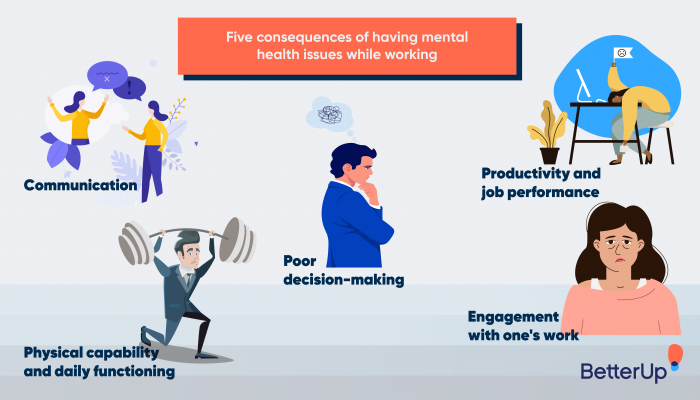How to Write a Workplace Mental Well-being Strategy?
The failure to address mental health problems, let alone recognize them, has festered unabated in various workplaces. This is mainly due to the stigmatization of people who come out with these challenges, or outright lack of concern and appreciation about the existence of mental health problems. In various workplaces, some of these problems are openly ignored – much to the chagrin of the employees, staff morale, and by extension to the organizational psyche.
However, employers and work environments are increasingly appreciating the discussion about mental health problems at the workplace and in the broader society. Towards this end, these employers are crafting workplace mental health strategies that are essentially organizational policy documents that help address and tackle mental health problems within their organizations.
This is a key step in the appropriate and right direction as it helps to demystify mental health problems, raise more awareness, and further create a safe space or atmosphere within the organization. Employees can thus know that they won’t face discrimination or any form of stigmatization when they speak up or outline their mental health problems. Crafting a workplace mental health strategy requires getting some aspects right – and this article looks at these aspects in detail.

Note Down the Status Quo
The current order and standing of things matter when considering a change in strategy. In this regard, therefore, the first step in writing a workplace mental well-being strategy is to note down the status quo. This is the prevailing set of working conditions, employees, and the state at the company at that period. Here, you need to ask questions on the current mental well-being policies, what they cover, and what they don’t. You also need to outline:
- The flow of work at your workplace.
- The pressure associated with the work.
- The overall confidence of your employees to balance work and handle other life matters.
- How mental well-being might become affected in the process.
Taking stock of the situation provides you with a base scenario and information to write a relevant workplace mental well-being strategy.
Identify Gaps and Areas of Focus
This is a crucial part of writing your workplace mental well-being strategy, as it brings to the fore the main areas that you should concentrate on as far as mental well-being goes. You can get this information by conducting anonymous surveys or by deploying other anonymous data collection methods, including the use of questionnaires. When you get the areas of focus, you can leverage them in writing your strategy by giving them the weight they deserve as far as your organization goes.
Be Concise about Objectives and Desired Results
Any strategy has as key aspects the set objectives and desired results. In this case of developing a workplace mental well-being strategy, you have to ensure that you are straightforward upfront about the objectives and desired results from the implementation of the said strategy. This brings life to the strategy, knowing that there are goals to meet and results to show throughout the implementation of the workplace mental well-being strategy. “Help me write my thesis as I am not in a position to meet all requirements,” says a student. In such a case, the student is concise about their objectives as they need someone to step in and handle their writing assignment. While most likely a writing service will get involved, the upfront action of being clear about their objectives and needs is what makes the difference here.
Underscore the Importance of Mental Well-being to Employee Productivity
In crafting a workplace mental well-being strategy, you should mention how important mental well-being is to employee productivity. You need to consider that employees with mental health problems will not be entirely productive and might impact workflow. When you use this point as a cornerstone for your strategy, you are highly likely to develop a strategy that appreciates mental health as a pretext to improved output and execution on the part of employees. More is achievable with employees who manage stress and are in good mental shape.
Expand the Scope of Tools and Resources
For purposes of keeping your workplace mental health well-being strategy up to date, you need to constantly expand the scope of tools and resources you are using to develop the strategy. Keep it all-encompassing and broad. In this regard, it is crucial to use the appropriate range of tools to address the challenge and the way it presents itself in workplace settings. Deploying more tools and resources to the process allows you to get a raft of solutions to implement as part of the broader strategy.
Consider Your Organizational Culture
Since the mental well-being strategy is for your organization and employees, you have to factor in the existing organizational culture in your strategy. You need to ensure that it reflects the way of doing things at the workplace. For any workplace strategy to succeed, it has to blend in with how employees get things done and the routines and systems they have established while at it. Appreciating this factor allows you to build a relevant, current, and fitting workplace mental well-being strategy that promotes healthy working and reflect the policies, processes, and protocols of the day-to-day operations of the workplace. This can help to bolster productivity at the workplace.

In summary, writing a workplace well-being strategy will depend on prevailing conditions at the workplace or organization, under-addressed areas, and infusing various tools and resources to develop a relevant strategy for responding to mental health problems.
Author’s Bio: Jessica Fender is an HR specialist with a long history of consulting, both with organizations and job seekers. She is also an editor at Writerswire.
